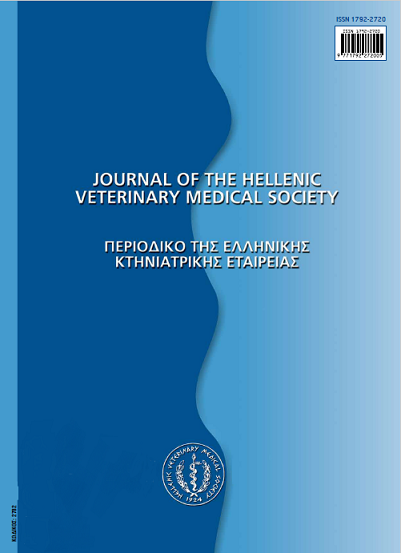Antimicrobial Resistance profile of Staphylococcus aureus from dairy cows with mastitis in the Region of Central Macedonia over a five-month period (March-July 2021)

Abstract
In Greece, a National Monitoring Plan for Antimicrobial Resistance in sick bovine animals was launched (2021). We aimed at surveying the antimicrobial resistance profiles of 118 pathogenic Staphylococcus aureus isolates obtained from dairy cows >18 months with mastitis in the Region of Central Macedonia from 1st March to 31st July 2021, where 45% (Census 2020: 69.186/128.511) of dairy cows in Greece are concentrated. By using the disk diffusion method (according to the CLSI guidelines), we tested susceptibility of isolates to nine antimicrobials (penicillin, cefoxitin, cefquinome, gentamicin, tetracycline, marbofloxacin, erythromycin, clindamycin, enrofloxacin) selected following the marketing amounts of animal use in Greece. In the study, 62/11 Staphylococcus aureus isolates were found to be resistant 52,54% to penicillin; 57/118 were 48,31% resistant to erythromycin, 56/118 were resistant 47,46% to clindamycin; 29/118 were 24,58% resistant to tetracycline and cefquinome both, 27/118 were 22,88% resistant to cefoxitin, 20/118 were 16,95% resistant to gentamicin, 3/118 were 2,54% resistant to marbofloxacin and, 2/118 were 1,69% resistant to enrofloxacin. Regarding the surveillance on the antimicrobial resistance of the Staphylococcus aureus isolates, that cause mastitis in cattle (penicillin in combination with an aminoglycoside, is the most commonly applied therapeutic treatment scheme against mastitis in Greece), to the β-lactams (penicillin, cefoxitin) it is needed further investigation, under the ‘One Health’ approach in respect to the prudent use of antibiotics in staphylococcal infections in humans and in the veterinary medicine in Greece. However, it seems that several kinds of interventions at farm level led to the protection of quinolones. The study offers a thorough understanding of the antimicrobial resistance patterns among Staphylococcus aureus isolates. The significant resistance rates to various antibiotics highlight the need for responsible antibiotic usage and continuous monitoring of resistance trends. These insights are crucial in developing effective strategies to tackle the emergence and dissemination of resistant strains and ensuring better treatment and control of infections caused by this bacterium. The findings add valuable knowledge to our understanding of antibiotic resistance and its implications.
Keywords: Antimicrobial Resistance; Staphylococcus aureus; mastitis; prudent use of antibiotics; One Health
Article Details
- How to Cite
-
Zafeiridis, C., Pavlidou, E., Giakkoupi, P., Vatopoulos, A., & Papadogiannakis, E. (2024). Antimicrobial Resistance profile of Staphylococcus aureus from dairy cows with mastitis in the Region of Central Macedonia over a five-month period (March-July 2021). Journal of the Hellenic Veterinary Medical Society, 75(2), 7531–7536. https://doi.org/10.12681/jhvms.35217 (Original work published July 11, 2024)
- Issue
- Vol. 75 No. 2 (2024)
- Section
- Research Articles

This work is licensed under a Creative Commons Attribution-NonCommercial 4.0 International License.
Authors who publish with this journal agree to the following terms:
· Authors retain copyright and grant the journal right of first publication with the work simultaneously licensed under a Creative Commons Attribution Non-Commercial License that allows others to share the work with an acknowledgement of the work's authorship and initial publication in this journal.
· Authors are able to enter into separate, additional contractual arrangements for the non-exclusive distribution of the journal's published version of the work (e.g. post it to an institutional repository or publish it in a book), with an acknowledgement of its initial publication in this journal.
· Authors are permitted and encouraged to post their work online (preferably in institutional repositories or on their website) prior to and during the submission process, as it can lead to productive exchanges, as well as earlier and greater citation of published work.



